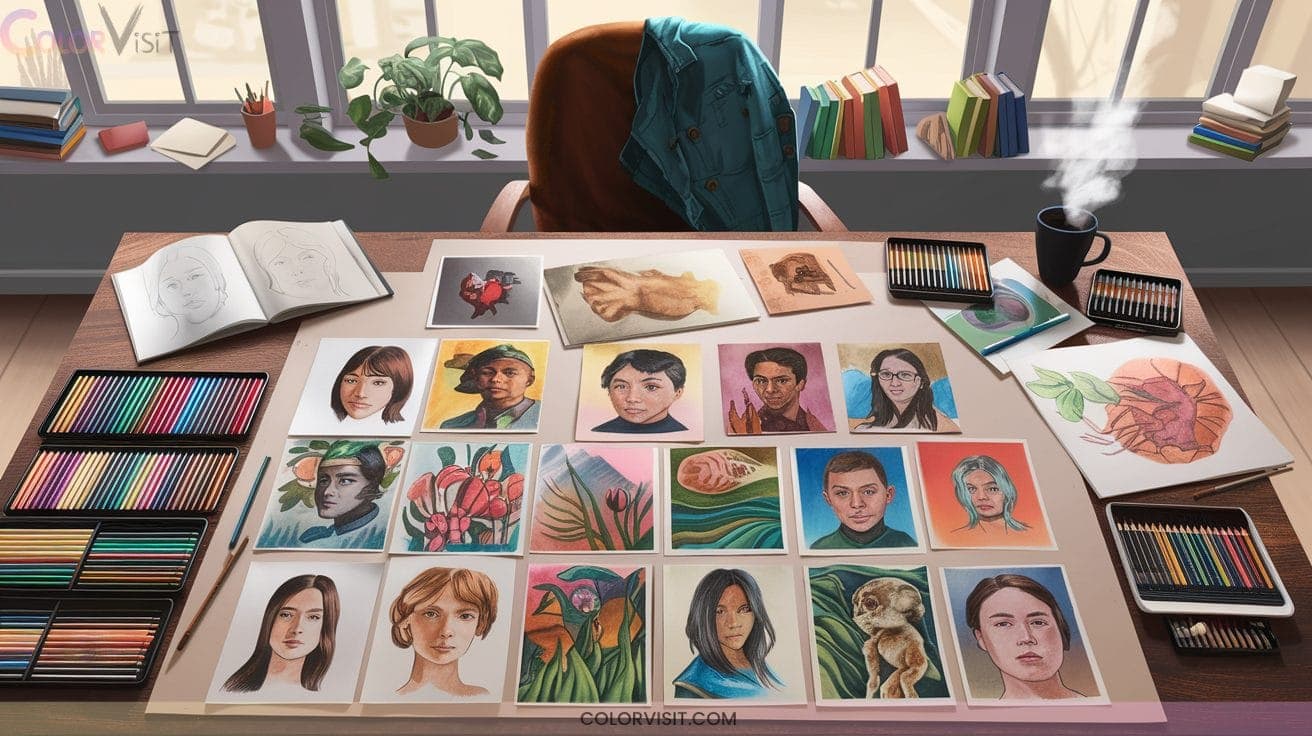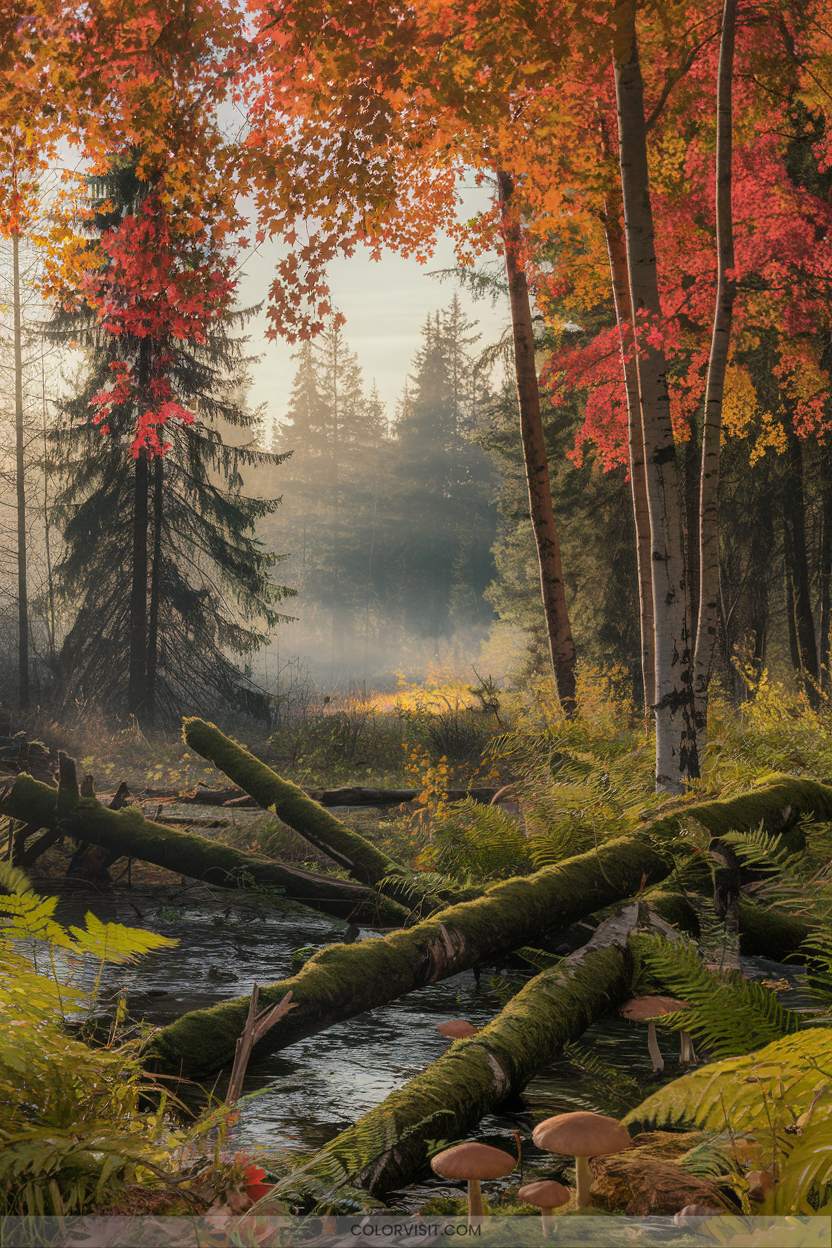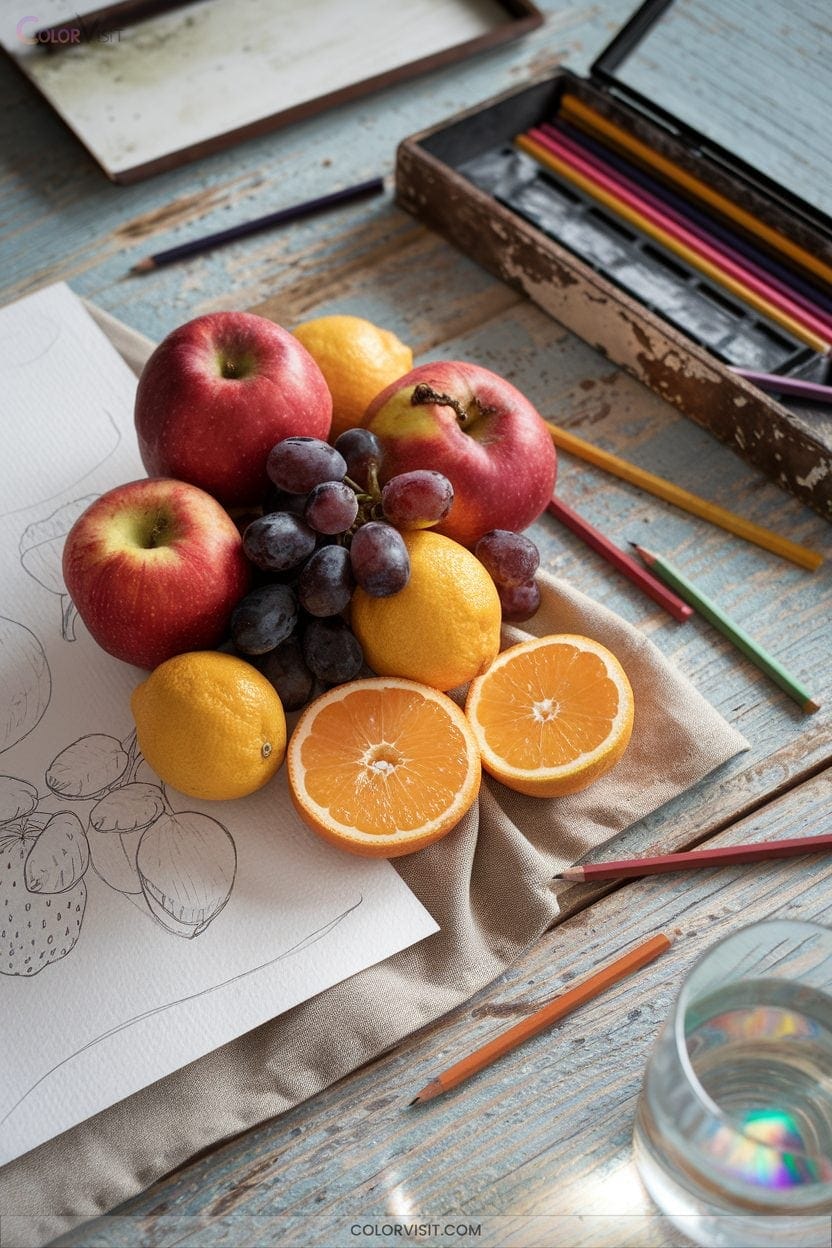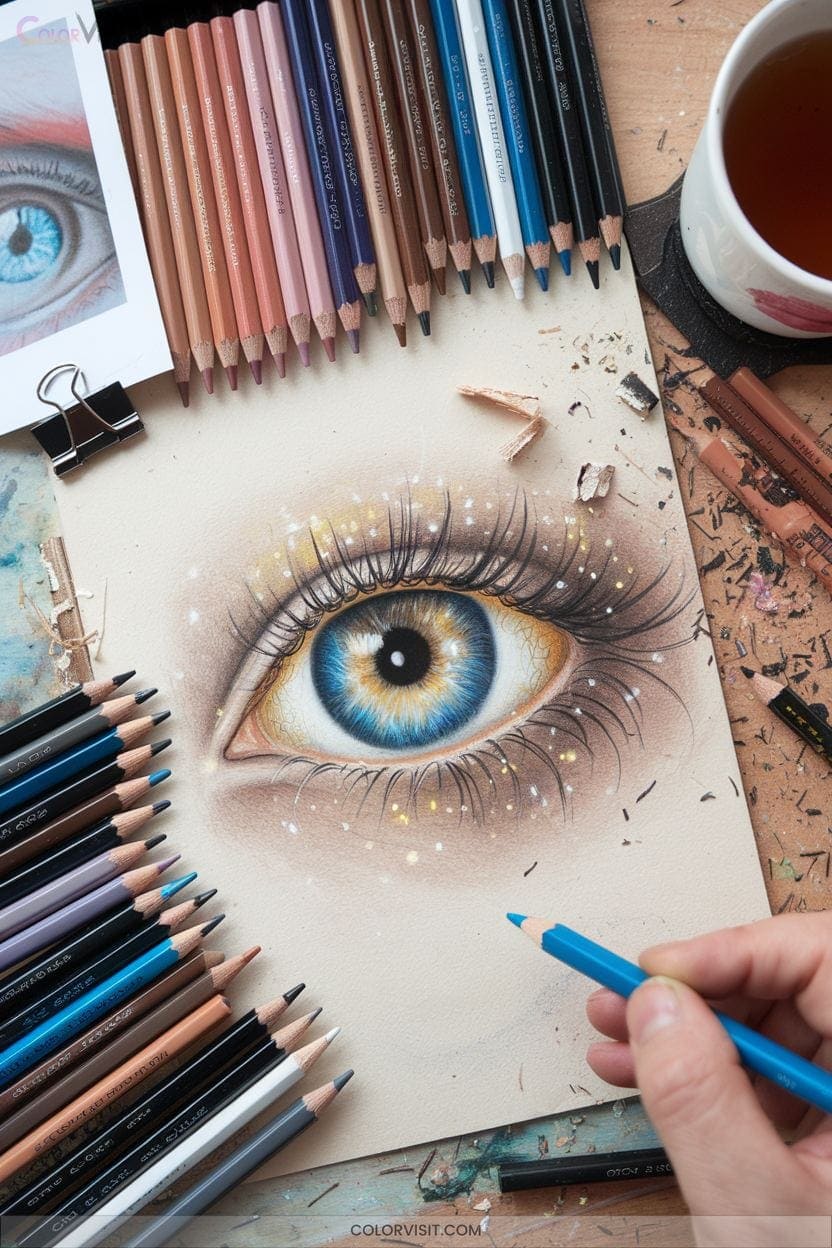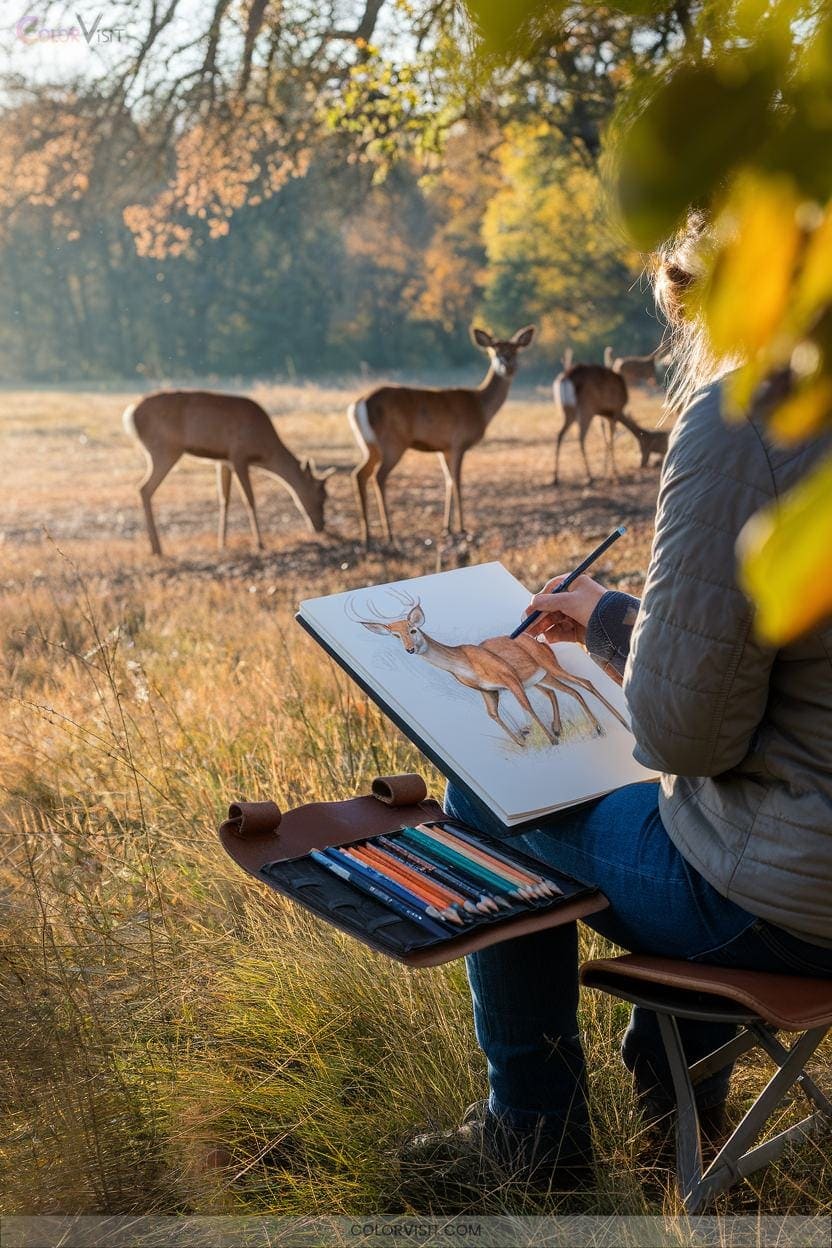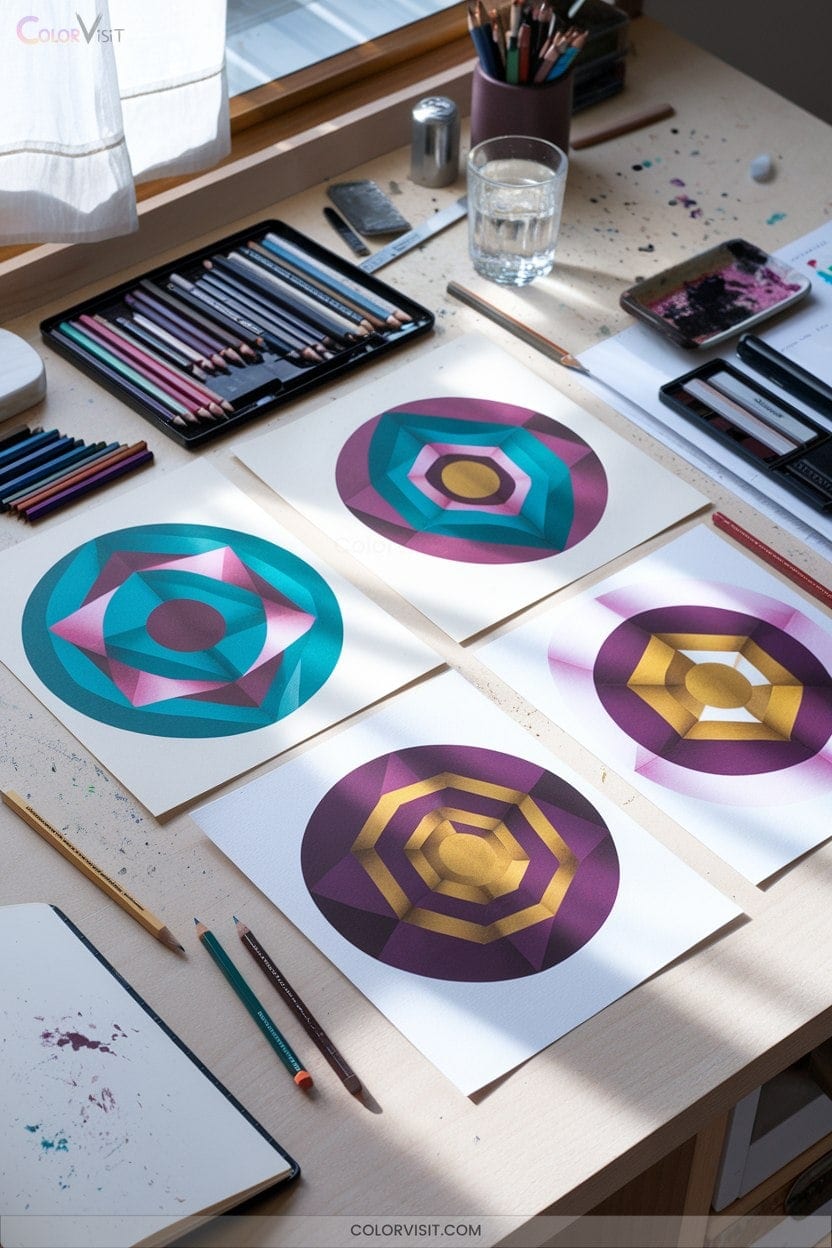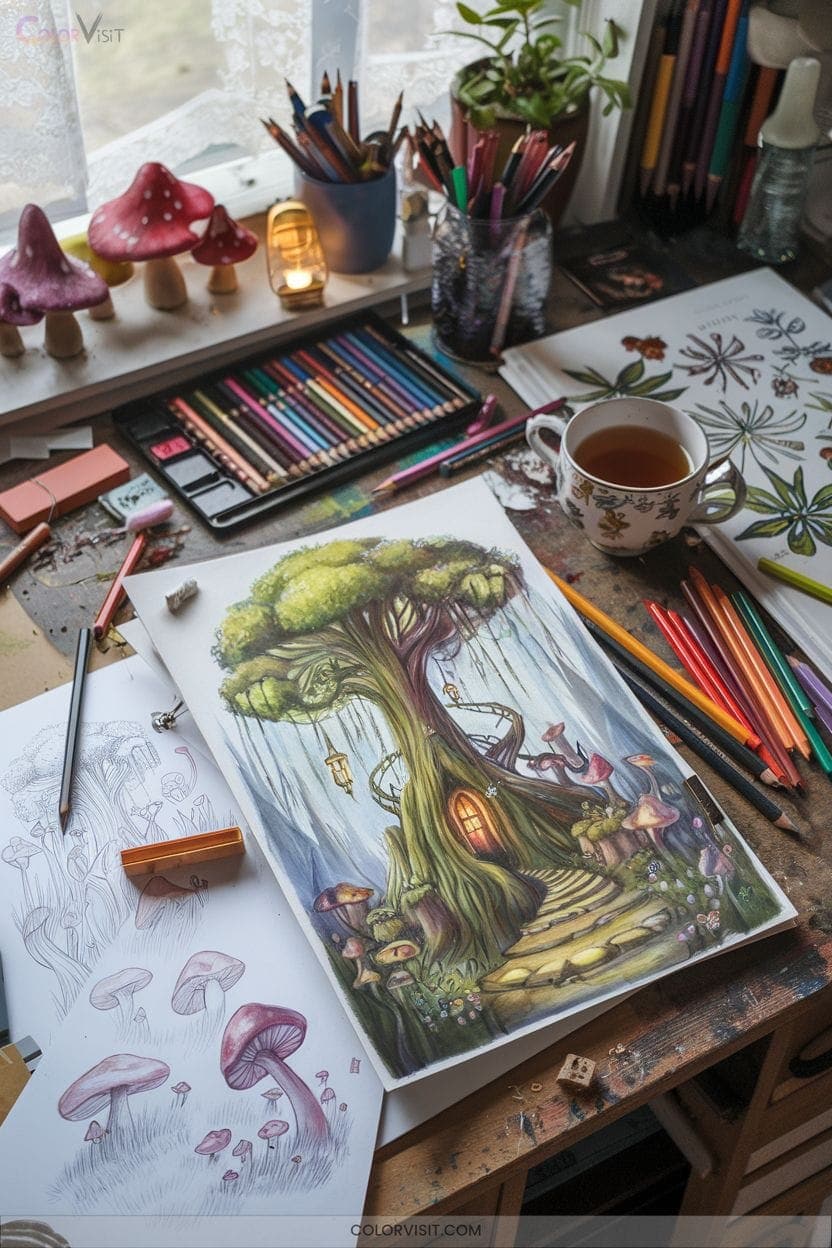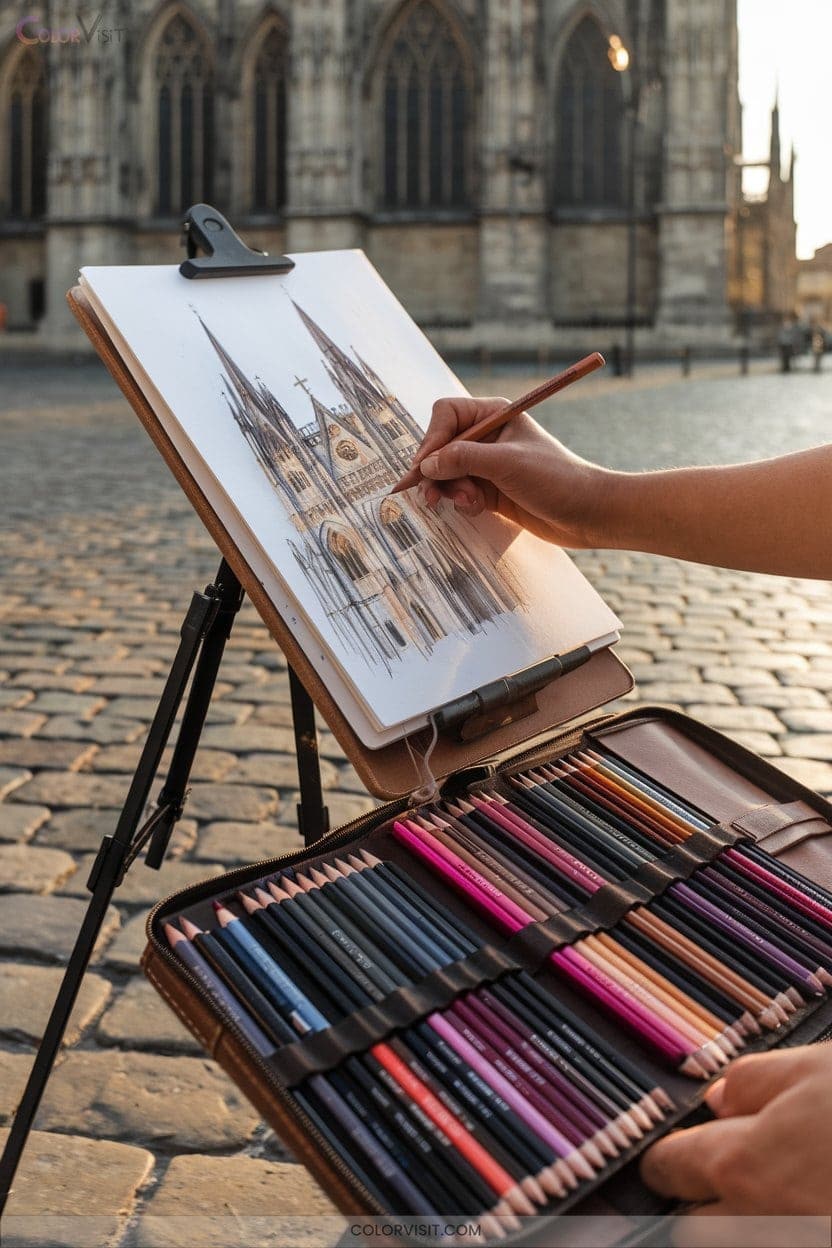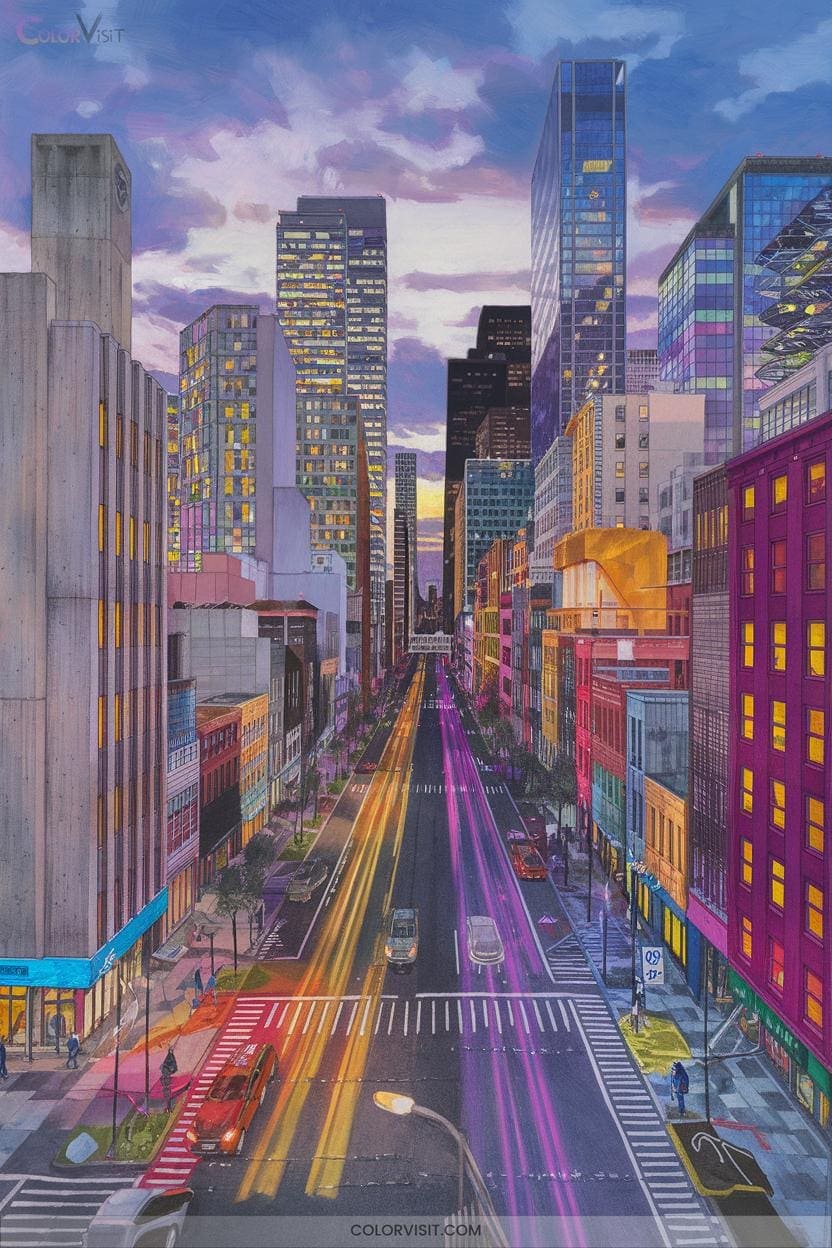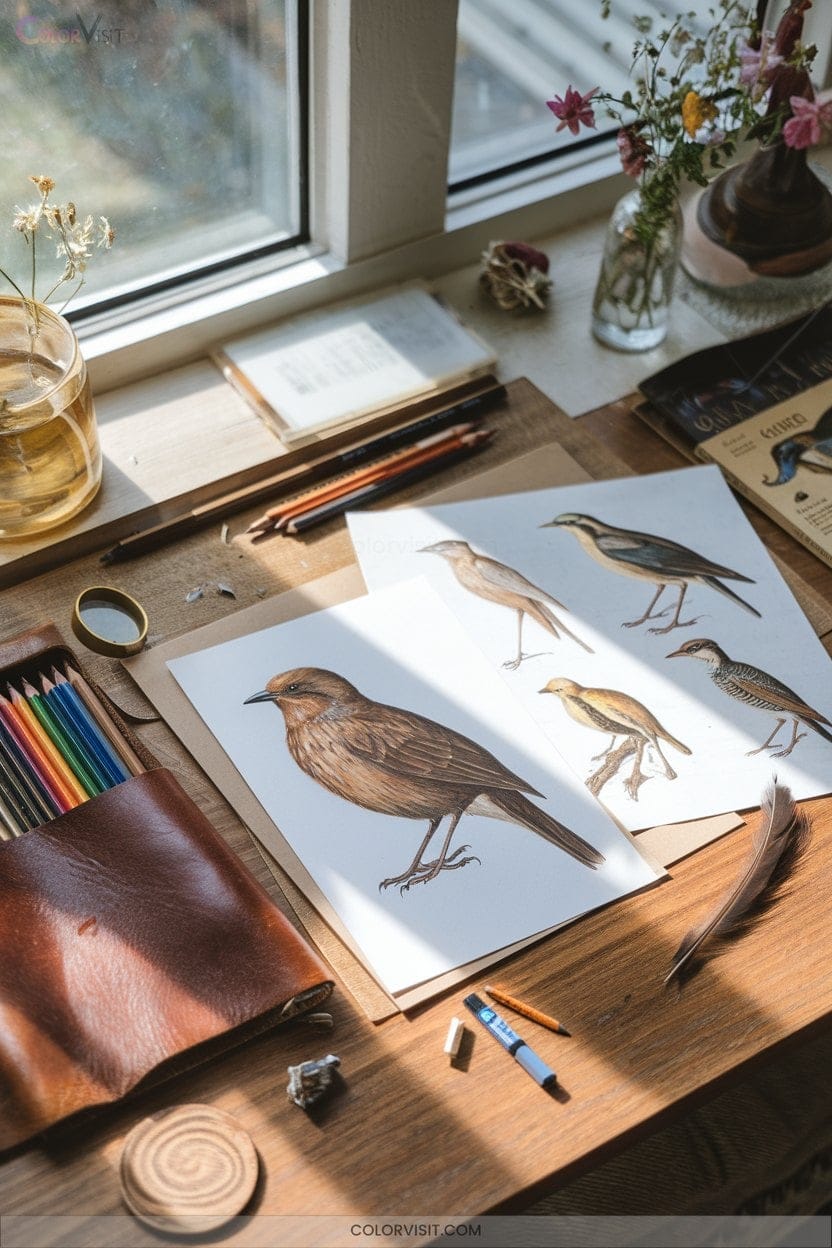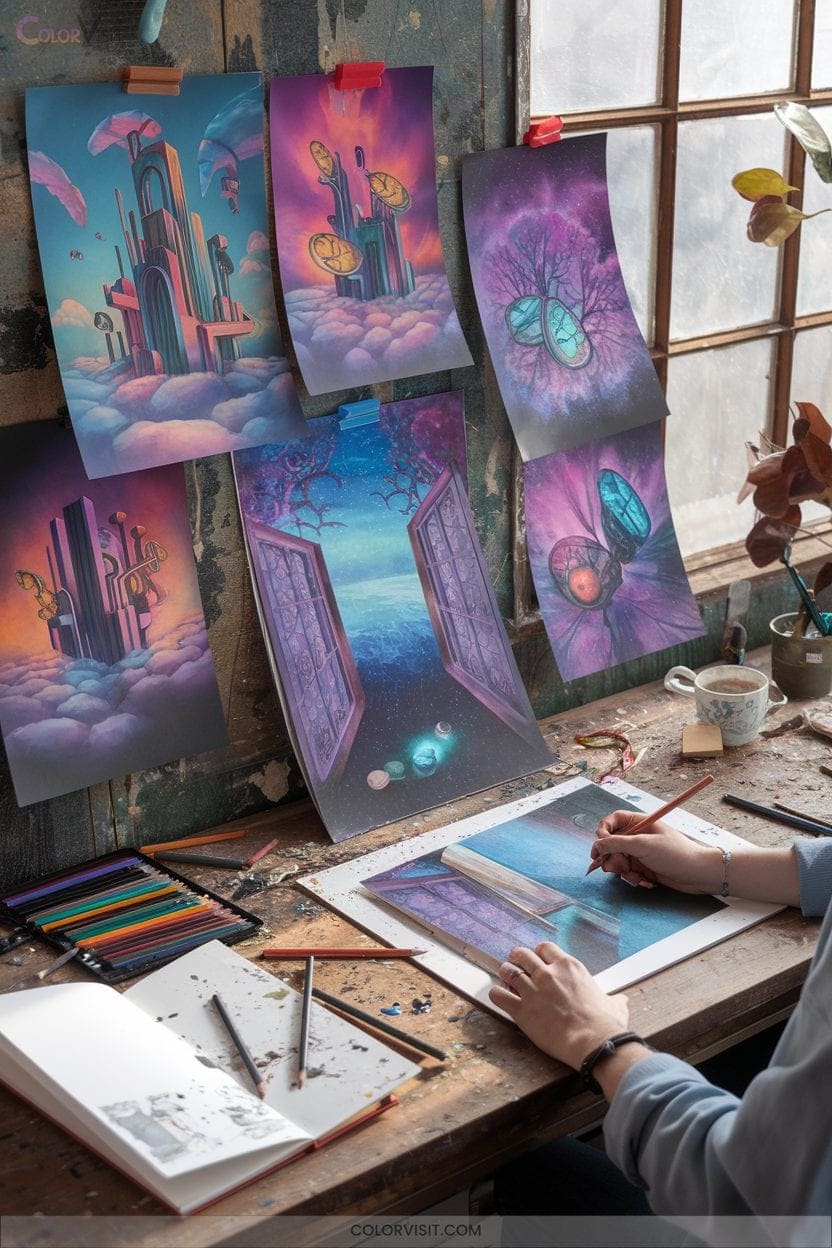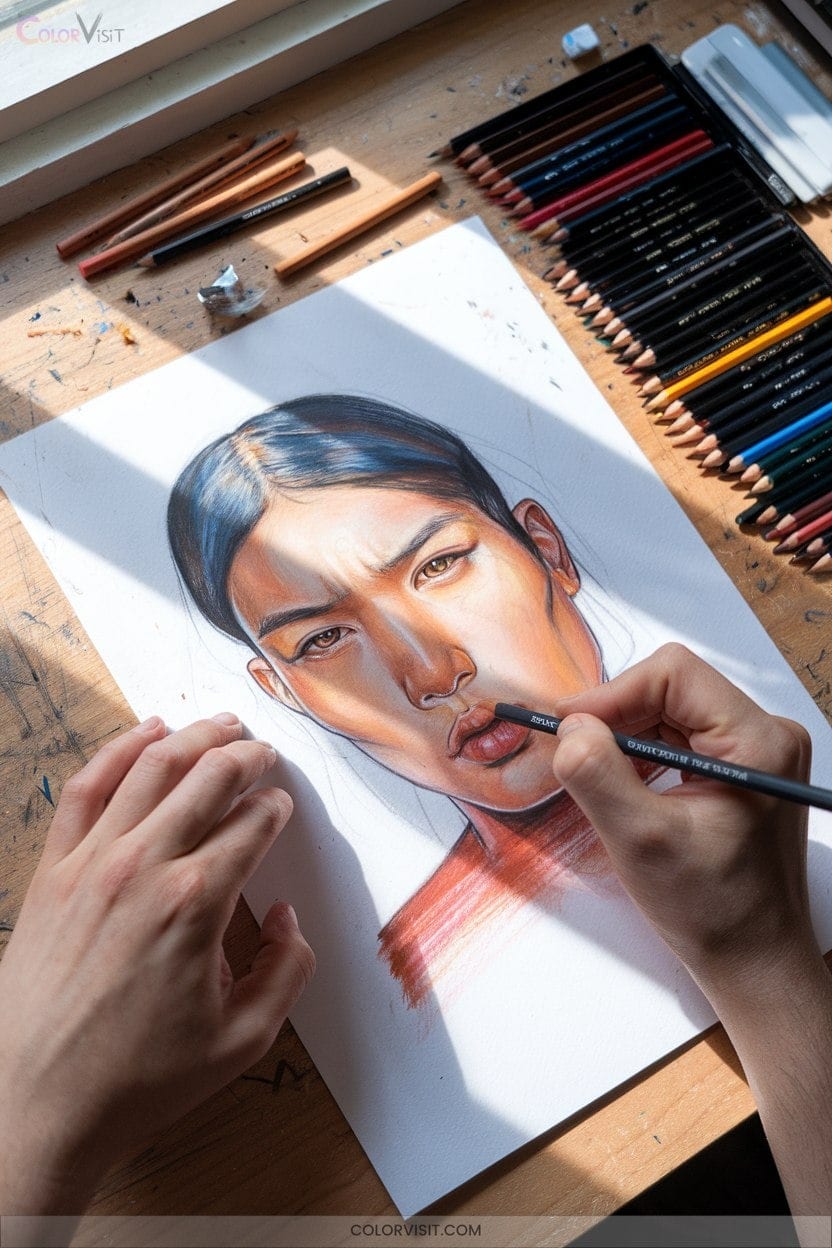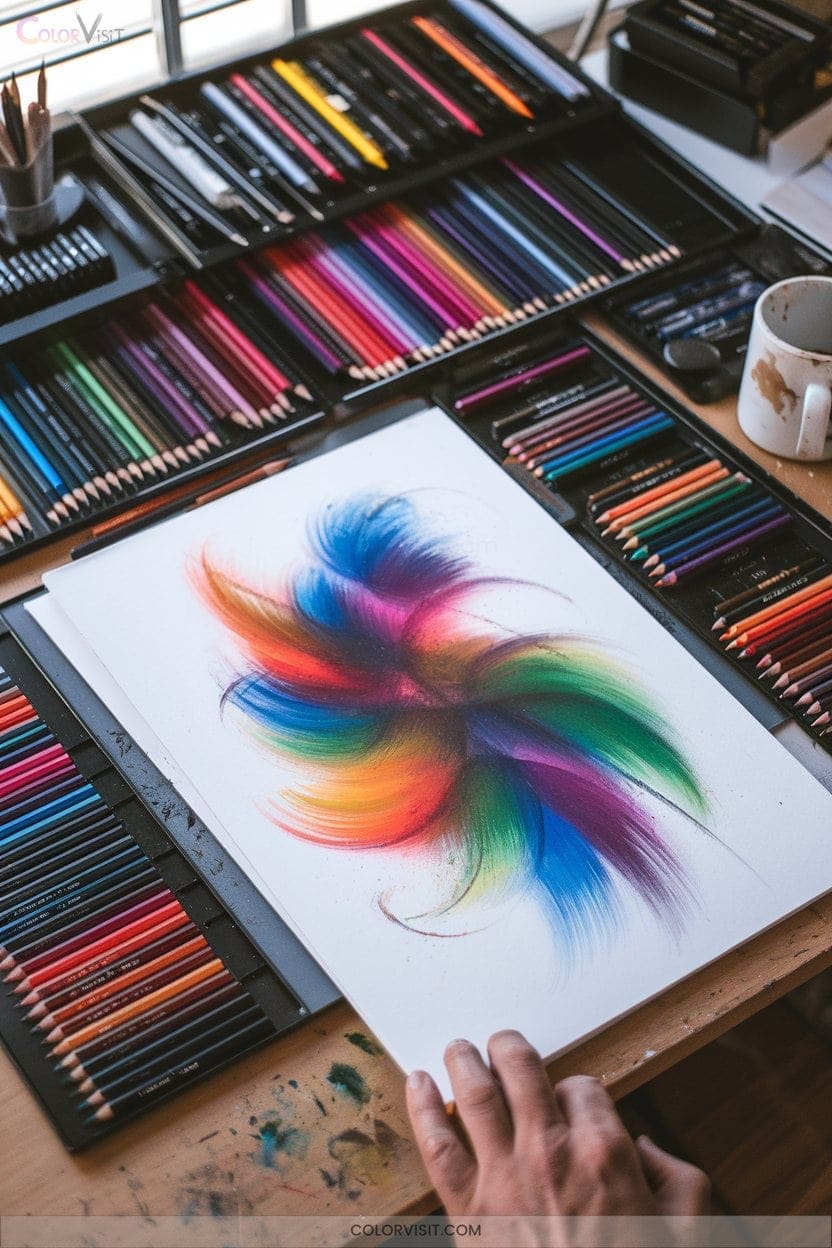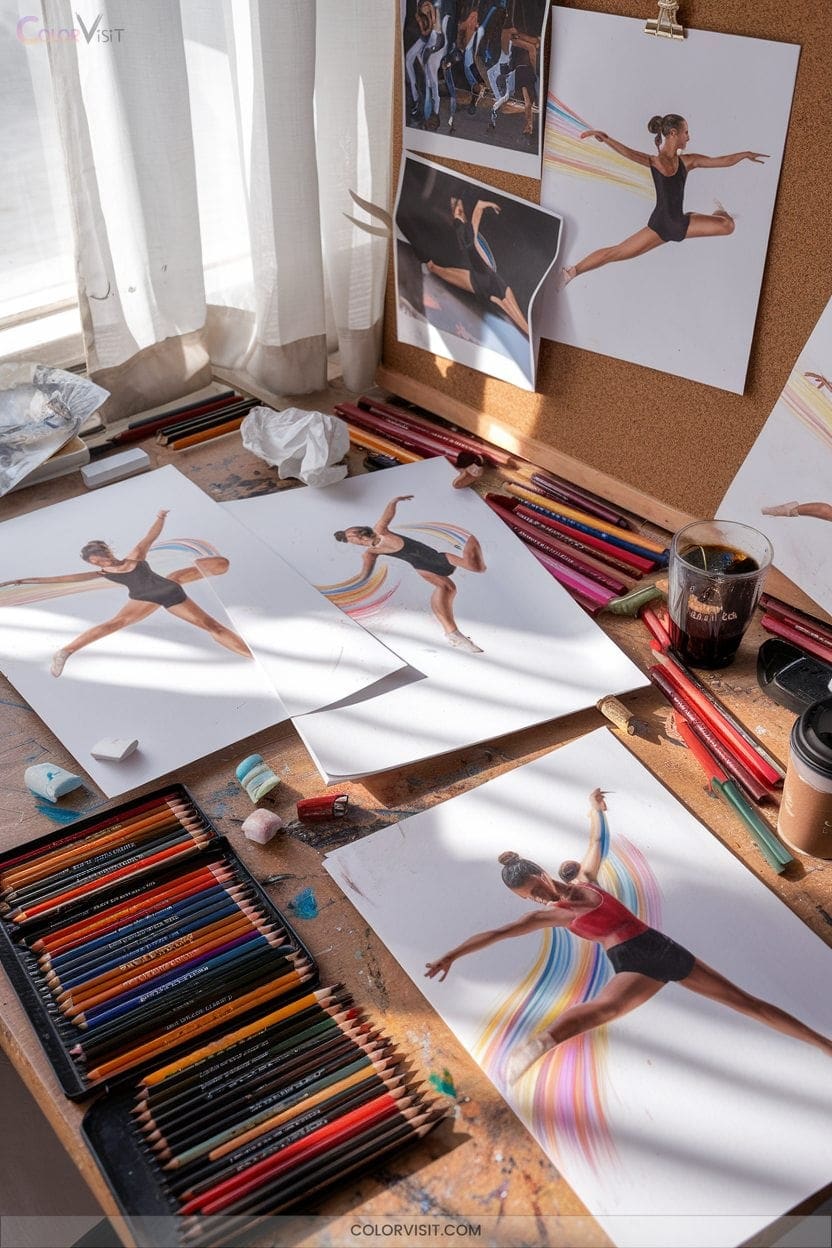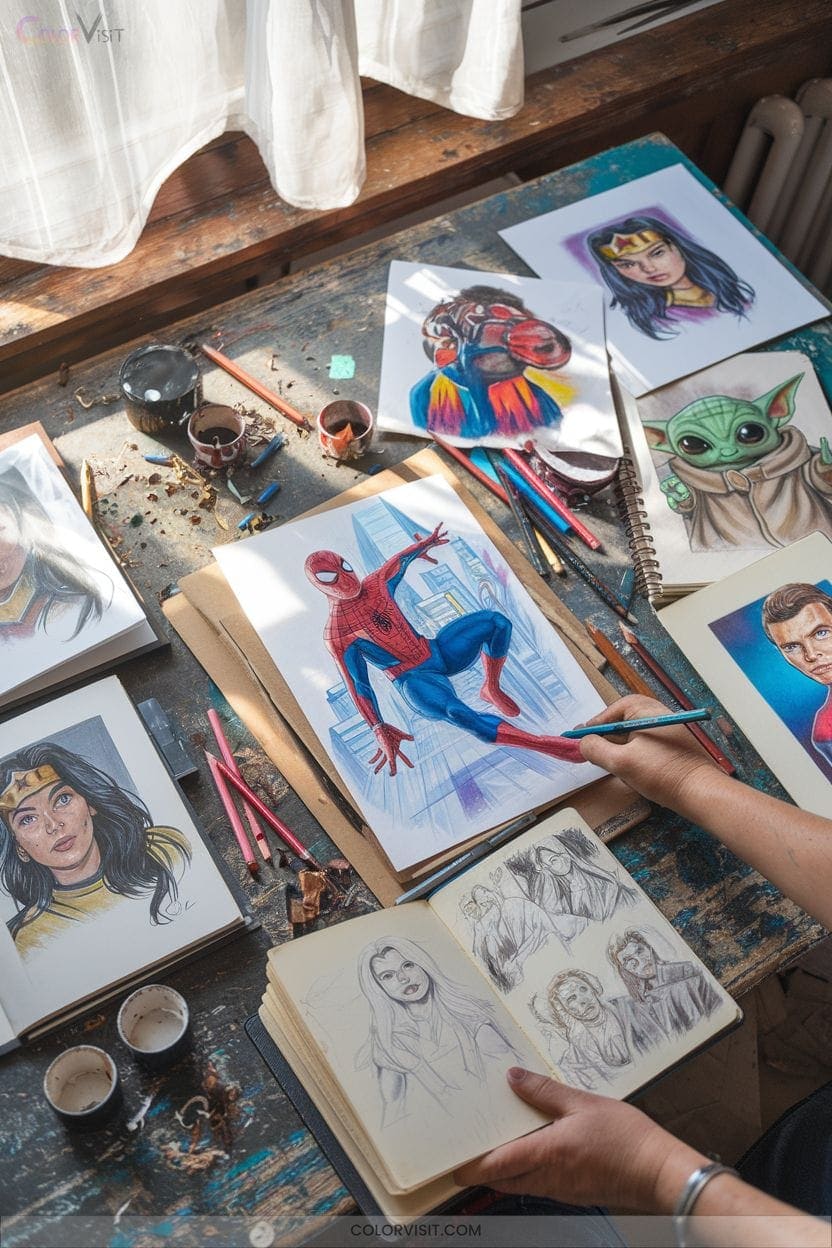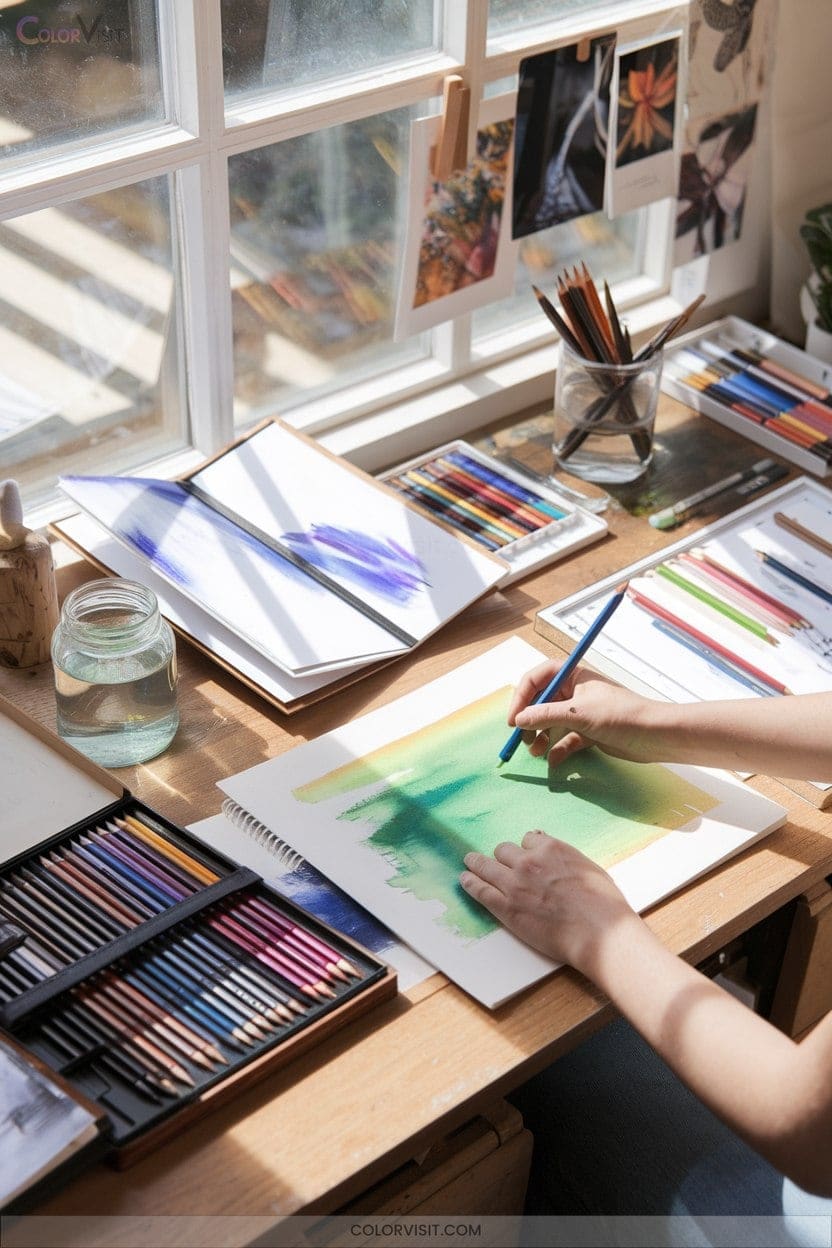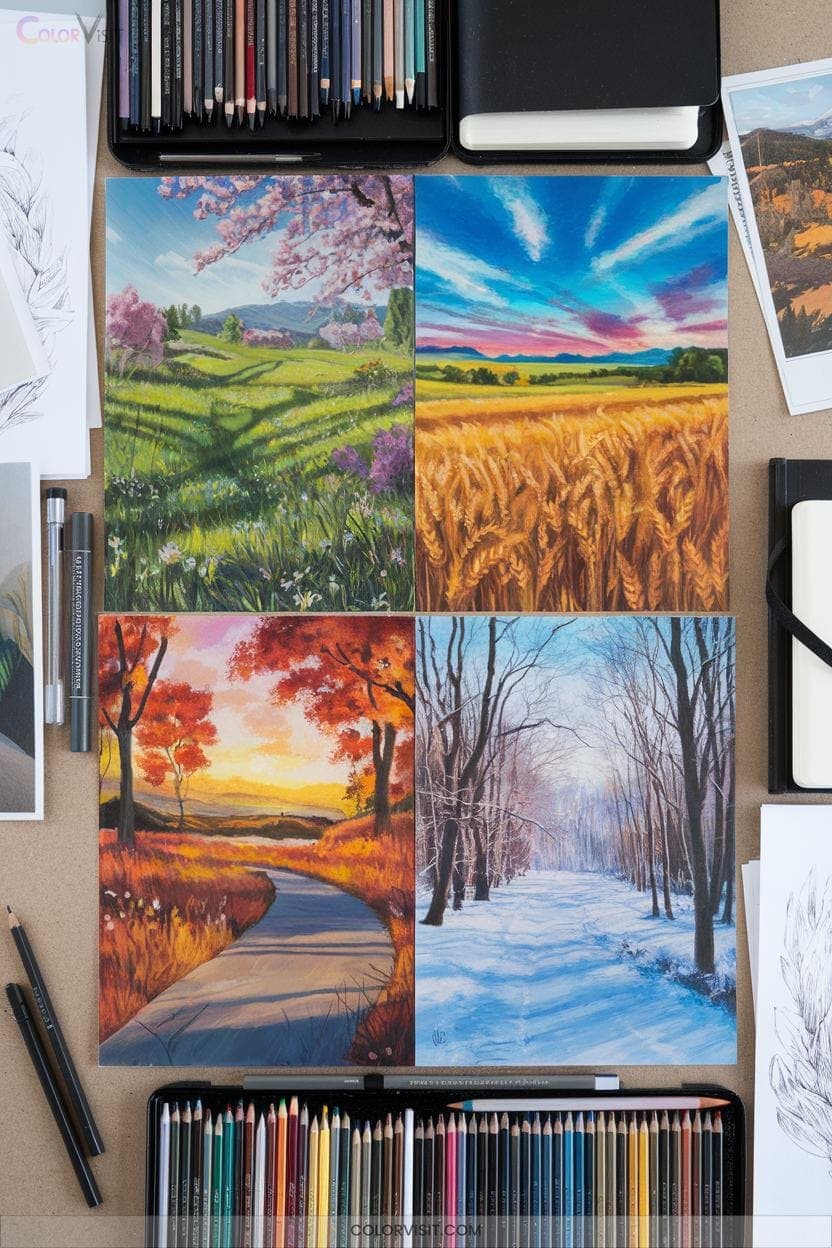20 Inspiring Color Pencil Drawing Ideas for Artists of All Levels
Unleash your creativity with 20 inspiring colored pencil drawing ideas, perfect for any skill level. Try lush forests, vibrant flower bouquets, and expressive animal portraits to master layering, pressure, and color blending. Immerse yourself in urban scenes, surreal compositions, or still life studies using cross-hatching and careful shading for depth.
Experiment with pop culture icons, mixed media, and atmospheric landscapes to fuel both technical skill and storytelling. You’ll discover techniques and imaginative themes to elevate every artistic session.
1. Nature Scenes: Trees and Forests
Trees serve as the backbone of compelling nature scenes, offering endless possibilities for color pencil drawings.
Trees form the heart of nature art, providing limitless inspiration for color pencil drawings and inviting creative exploration.
Begin by blocking in basic shapes—broad ovals for deciduous canopies or triangles for conifers—so you’ll maintain overall structure and balance.
Pay attention to branch structure: mix solid lines and broken strokes to create convincing depth.
For bark, use cross-hatching and varied pressure to add rugged texture.
Layer colors—greens, blues, yellows—for vibrant foliage, always considering your light source.
Place lighter, detailed trees in the foreground and darker silhouettes behind to build spatial depth.
Innovate with eraser highlights to simulate sunlight streaming through branches.
2. Drawing Vibrant Flower Bouquets
Why do some flower bouquets leap off the page while others fall flat?
The secret lies in strategic layering and innovative color blending.
Begin with light pink or purple underlayers, building depth with magentas and cool undertones for realistic whites.
Elevate vibrancy—layer complementary greens into red flower shadows.
Burnish petals using a light pencil for gloss, then overlap blooms at varied stages for dynamic composition.
Guide the viewer’s eye with angled stems and negative space.
For leaf realism, alternate directional strokes and lift veins with a precision eraser.
Work petal-by-petal, referencing high-res photos for tonal accuracy, and optimize your surface choice.
3. Exploring Simple Still Life With Fruit
A classic still life with fruit challenges you to balance technical precision with expressive composition.
Begin by sketching transparent wireframes with a 2B pencil to establish accurate proportions and spatial relationships.
Layer colored pencils, leveraging hatching, cross-hatching, and stippling to articulate each fruit’s distinct surface—think citrus rind or peach fuzz.
Burnish for polished highlights and blend gradient shadows to define volume and form.
Strategically subtract or leave blank areas in deep shadows to intensify light effects and direct focus.
Compose contrasting shapes and textures, overlap forms for depth, and edit out distractions to emphasize the most luminous and compelling features.
4. Capturing Everyday Objects in Detail
While fruit still lifes offer a chance to refine your handling of form and color, everyday objects present a new set of challenges that push your observational skills further.
To capture their complexity, start with a precise line outline, then layer colors using cross-hatching, scumbling, and back-and-forth strokes.
Observe how light and shadow interact across surfaces—use varied pressure and pencil grades to recreate gradients and subtle textures.
Select items with intriguing material contrasts, like mugs or watches, and experiment with toned papers or hybrid media for added depth.
Focus on accurate proportions, and let each section reveal its unique detail through layering.
5. Animal Portraits With Realistic Fur
Rendering lifelike animal portraits with colored pencils demands a deliberate approach to both texture and structure, especially when tackling the intricate challenge of fur.
Start with a limited palette and lay down undertones to avoid flatness.
Layer light, directional strokes that mirror fur growth, alternating warm and cool hues for optical depth.
Zone your drawing—divide chest, back, and legs—so each section’s fur direction feels natural.
Use sharpened pencils and vary line weights; guard hairs need crisp emphasis.
Employ blending stumps and burnishing for smoothness, then lift highlights and scratch in whiskers.
Constantly assess from a distance to perfect balance and realism.
6. Creating Lifelike Human Eyes
How do you capture the subtle luminosity and complexity of a human eye with colored pencils?
Start by layering a spectrum of hues—don’t limit yourself to basic blues or browns.
Observe the iris: add delicate striations, veins, and intricate patterns using sharp pencils for precision.
Employ burnishing and blending stumps to merge tones seamlessly, while preserving detail.
Reference real eyes to replicate the pupil’s depth and the sclera’s subtle texture.
Illuminate your drawing with strategic corneal highlights and nuanced shadows.
Integrate eyelids and lashes with careful proportion.
Innovation emerges from layering, attentive observation, and mastering color blends for lifelike results.
7. Sketching Wildlife in Their Habitat
Immersion defines successful wildlife sketching—your colored pencils must capture not only the animal’s anatomy but also its relationship to the surrounding habitat.
Choose heavyweight, toothy paper like Pastelmat for layered textures, and keep pencils razor-sharp with a Swordfish sharpener for fur detail.
Use Derwent Pro Colors, blending ochres and blacks for luminous shadows, and apply oil-painting-inspired dark-to-light layering.
Integrate PanPastels for atmospheric bases and create bokeh backgrounds with blending stumps.
Foreground flora demands crosshatched strokes in Olive Green and Yellow Ochre.
Research local plant life and maintain a precise scale ratio to ground your wildlife subjects authentically.
8. Geometric Pattern Designs
A foundation in geometric pattern design opens a world of creative precision with colored pencils.
Start by sketching grids for symmetry, then experiment with spheres, prisms, and hexagons to build dynamic patterns.
Master layering, blending, and burnishing to achieve optical illusions and vibrant effects—contrasting colors like orange and purple add striking depth.
Draw inspiration from architecture or abstract art to innovate your own motifs.
Tutorials across digital platforms provide step-by-step guidance, and sharing results in online communities fuels creative growth.
9. Illustrating Whimsical Fantasy Worlds
Building on the structured elegance of geometric patterns, illustrating whimsical fantasy worlds invites you to construct entire worlds fueled by imagination.
Begin with thumbnail sketches to anchor your vision, then shape mythical creatures and magical terrains with bold, experimental forms.
Elevate realism by layering intricate textures, luminous colors, and dynamic lighting.
Control mood and narrative through thoughtful composition and strategic use of color theory.
Let these core techniques ignite your creative ambition:
- Envision creatures and landscapes that defy reality
- Layer textures for tactile dimension and depth
- Manipulate color and light to evoke emotion
- Compose immersive scenes rich with narrative potential
10. Rendering Historical Buildings and Architecture
Mastery of architectural rendering demands a keen eye for proportion, perspective, and the nuanced details that define historical buildings.
Begin with sharp observation—capture intricate carvings, ornate facades, and unique structural elements in your initial sketch.
Select colors reflecting the building’s era and material: earth tones for aged stone, subtle hues for period-appropriate accents.
Apply shading that responds to natural light, emphasizing texture and depth.
Render classical columns, arches, and elaborate rooflines with precision.
Meticulously detail windows, doors, and masonry, preserving historical authenticity.
Finally, enrich your composition by integrating contextual elements—trees, figures, or vehicles—to ground the structure in its environment.
11. Colorful Urban Cityscapes
After refining your skills with historical architecture, channel that attention to detail and sense of proportion into vibrant urban cityscapes.
Use Caran D’Ache Luminance pencils or versatile pencil sets to achieve bold color palettes and intricate textures.
Layer and blend pigments with precision, leveraging pressure control for dynamic shading and luminous highlights.
Capture the energy of bustling streets, iconic landmarks, or glowing night scenes by observing real-life moments or referencing photos.
Let your innovation shine as you balance light, shadow, and composition.
- Experience the pulse of city life
- Illuminate architectural details
- Capture fleeting light and color
- Express urban vibrancy boldly
12. Textured Feathers and Bird Studies
Intricacy defines feather and bird studies, where each stroke must capture both the softness and structure unique to avian subjects.
You’ll combine circular and flicking motions with colored pencils to sculpt smooth gradients and textured barbs. Layer color deliberately, deepening shadows and blending gradients for lifelike volume.
Use short, directional strokes to suggest feather flow, reserving sharp pencil tips for edges and highlights.
Observe reference images closely—each species and feather type presents distinct patterns and challenges. Achieve fuzzy or sleek effects by adjusting pressure and stroke.
Prioritize anatomical accuracy, and let selective detail guide focus, shaping dynamic, innovative avian portraits.
13. Surreal Compositions With Dreamlike Elements
How do you translate the logic-defying nature of dreams onto paper?
Start by fusing realism with fantasy—let vibrant color schemes and gradation blur the boundary between believable and bizarre.
Push boundaries by breaking perspective rules, manipulating scale, and weaving hidden symbolism throughout your scene.
Think of your composition as a visual riddle, inviting viewers to decipher meaning.
To evoke genuine wonder, experiment boldly:
- Juxtapose unrelated objects for surprise
- Infuse mirrors or reflections for infinite depth
- Layer textures using burnishing and hatching
- Embrace negative space to amplify surreal tension
Your colored pencils become instruments of innovation, forging unprecedented dreamscapes.
14. Portraits With Expressive Facial Features
Emotion forms the core of compelling portraiture, and colored pencils offer remarkable control for capturing expressive facial features.
Emotion drives powerful portraits, and colored pencils provide unmatched precision for rendering the subtle nuances of facial expression.
Start by mapping values in grayscale to master light and shadow interplay.
Use a light graphite underdrawing to secure proportion, then layer color in at least three passes—reserving highlights on white paper for vibrancy.
Select cool gray paper and oil-based pencils for ideal blending and luminous skin.
Apply directional strokes for natural hair, crosshatch shadows for depth, and manipulate color temperature to evoke mood.
Limit your palette and strategically accentuate eyes or lips for psychological impact.
Always balance precision with expressive mark-making.
15. Abstract Art Using Bold Color Blends
While realistic portraits demand precision and subtlety, abstract art with bold color blends invites you to break free from representation and focus on raw visual impact.
Embrace geometric versus organic contrasts, layering translucent hues to create deep optical intrigue.
Push vibrancy by blending complementary colors—think electric blue and orange—or build subtle drama with muted dissonance and value extremes.
Use dynamic mark-making and texture, from dry crosshatching to solvent blending, to energize each composition.
Let negative space breathe amidst the intensity.
Abstract drawing isn’t just visual—it’s emotional.
Let these techniques provoke:
- Tension and release
- Surprise and curiosity
- Energy and flow
- Harmony and disruption
16. Dynamic Action Poses and Movement
Capture the energy of movement by focusing on dynamic action poses—where every line and angle suggests motion and life.
Let every line and angle in your drawing pulse with motion, capturing the vibrant energy of dynamic action poses.
Start with gesture drawing using felt pens and copier paper to quickly establish the action line, emphasizing the flow and rhythm.
Reference dynamic pose collections or film stills for inspiration.
Master foreshortening to inject depth, and layer expressive line work with vibrant color pencil techniques for emotional impact.
Don’t hesitate to experiment with textures, blending, and media—digital or traditional.
Practice with a stopwatch to improve speed and fluidity.
Refine anatomical accuracy, and always prioritize movement over static precision for innovative results.
17. Tranquil Water Scenes and Reflections
A tranquil water scene offers a unique opportunity to explore the nuanced interplay of light, color, and reflection with colored pencils.
Analyze natural light’s effect on water to distinguish subtle surface ripples and mirrored landscapes.
Layer transparent blues, greens, and grays with precision, using smooth strokes and blending tools to evoke depth and serenity.
Carefully balance highlights and shadowed depths to achieve luminous, glasslike reflections.
Let these moments inspire your creativity:
- Experience the meditative calm of mirrored skies
- Capture fleeting ripples with confident, expressive marks
- Convey silence through soft gradations and negative space
- Evoke wonder as light dances across tranquil surfaces
18. Pop Culture Characters in Color
Shifting from serene natural landscapes to the vibrant world of pop culture, colored pencil artists encounter new challenges and opportunities for technical mastery.
When you render iconic characters from franchises like Toy Story or Marvel, accuracy is paramount—reference images guide your hand in capturing subtle facial features and dynamic costumes.
Experiment by combining rivals, such as Batman and Joker, to explore narrative contrast.
Layer vibrant colors for depth, and use precise composition to balance multiple figures.
Sharing your work on Instagram or Pinterest connects you with engaged fans, while participating in online challenges sharpens your technique and expands your creative repertoire.
19. Mixed Media Experiments With Colored Pencil
How do you elevate your colored pencil work beyond traditional boundaries?
Mixed media unveils a world of innovative expression.
By blending colored pencil with alcohol markers, watercolors, or PanPastels, you achieve depth, vibrancy, and textures impossible with pencils alone.
Use thick, hot-press watercolor paper or clay-coated boards for robust layering, and embrace fixative sprays to control media bleed.
Experiment fearlessly:
- Layer gouache for striking opacity beneath translucent pencil glazes
- Outline in ink, then shade for sharp, dynamic contrast
- Blend white pencil atop watercolor for ethereal highlights
- Collage tissue or text under pencil for tactile depth
Push your artistic vision further.
20. Seasonal Landscapes Through the Year
Each season offers a distinct palette and atmospheric character, challenging you to adapt your colored pencil techniques for heightened realism and mood.
Spring calls for pastel layering—light greens and pinks—plus crisp detailing in fresh grasses and reflections.
Summer demands saturated ochres, bold shadows, and heat-induced textures for parched earth.
Autumn pushes you to master earthy overlays, randomized leaf litter, and golden skies blending into haze.
Winter tests your control with cool palettes, preserved highlights, and dramatic cloudwork.
Innovate by blending palettes at seasonal edges, varying focus, and adding contextual cues—like migratory birds or holiday decor—to evoke time’s passage and climate’s subtle shifts.
Frequently Asked Questions
What Type of Colored Pencils Are Best for Beginners and Professionals?
You’ll want soft-core pencils like Arteza or Prismacolor for easy blending as a beginner. As a professional, opt for Faber-Castell Polychromos or Caran d’Ache Pablo for unrivaled lightfastness, color range, and performance. Innovate confidently.
How Do I Prevent Colored Pencil Drawings From Smudging or Fading Over Time?
Want to guarantee your colored pencil art stays vibrant and pristine? Apply non-yellowing fixatives between layers, use archival sprays for UV protection, draw methodically to reduce smudging, and always test protective coatings for compatibility—innovation elevates preservation.
Is It Necessary to Use a Fixative for Colored Pencil Artwork?
You don’t always need fixative for colored pencil work, since pencils resist smudging. However, if you’re using sanded papers, layering heavily, or want added protection and surface tooth, a fixative can enhance both durability and creative possibilities.
How Can I Effectively Erase Mistakes Made With Colored Pencils?
You’ll erase colored pencil mistakes best by layering marks lightly, using kneaded or Tombow Mono Zero erasers with a dabbing motion, and testing first. Combine techniques, warm erasers in your hands, and always protect your paper’s integrity.
Which Paper Textures Work Best With Colored Pencils for Smooth Blending?
As the saying goes, “Smooth seas never made a skilled sailor”—but smooth paper makes masterful blending. You’ll achieve seamless gradients and photorealism with hot-press or plate-finish surfaces, where minimal tooth eliminates distracting grain and enables innovative layering.
Conclusion
Think of your colored pencils as a fleet of ships, each hue charting new waters across the vast sea of your imagination. With every drawing, you navigate uncharted islands—nature, portraits, pop culture—gathering treasures of skill and creative vision.
Don’t anchor in familiar harbors; let curiosity captain your journey. With these ideas as your map, set sail boldly, knowing each sketch brings you closer to mastering the artful ocean of colored pencil drawing.
